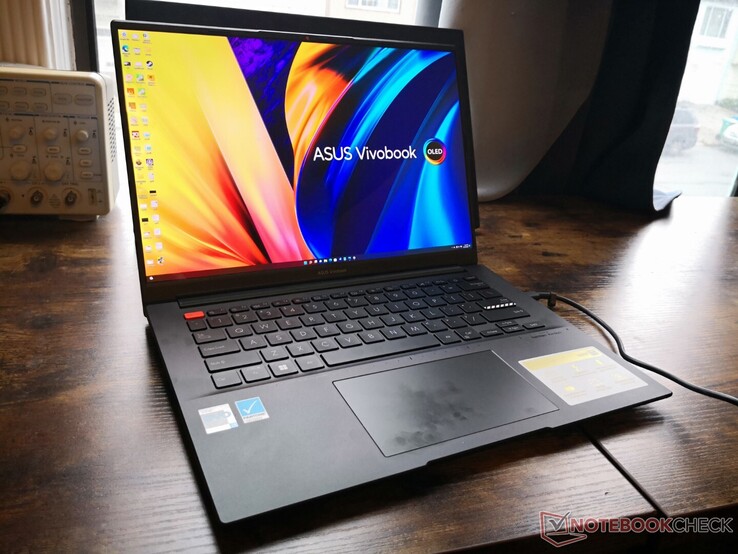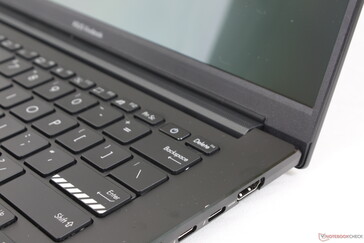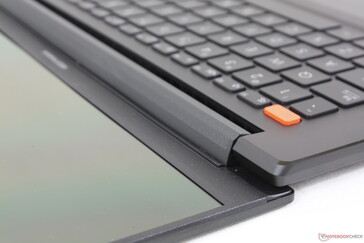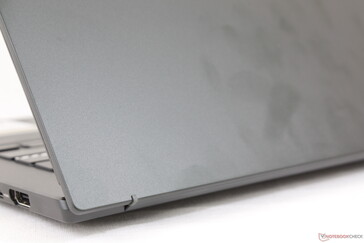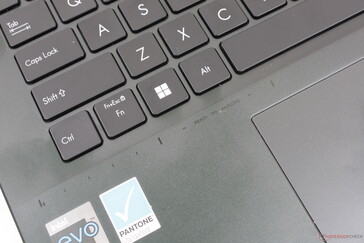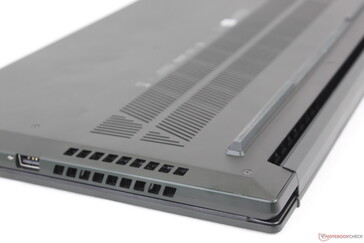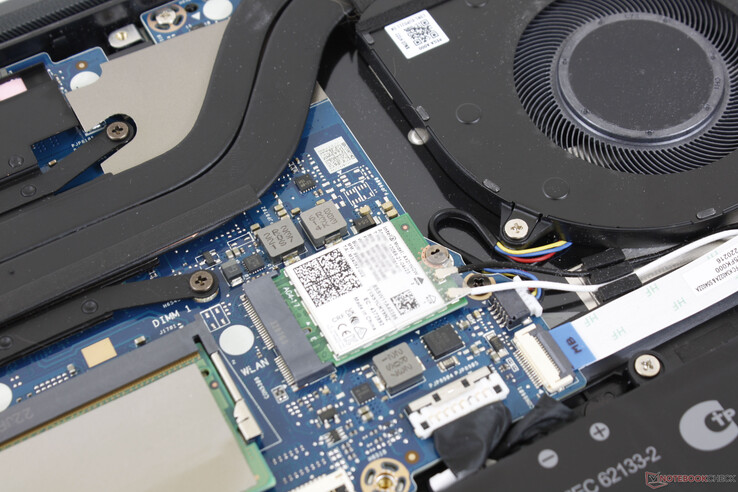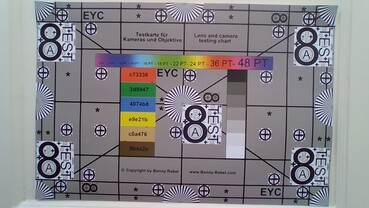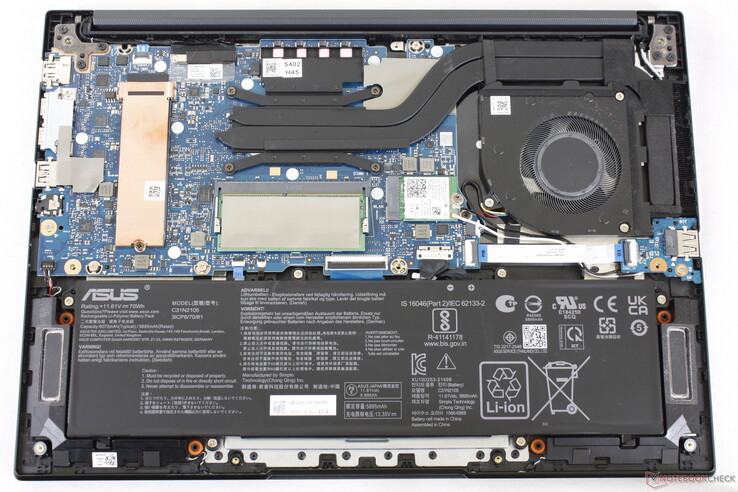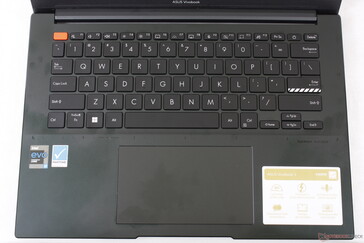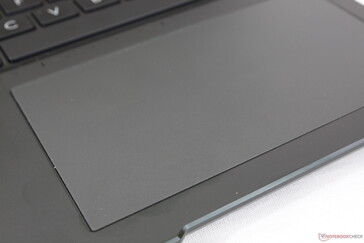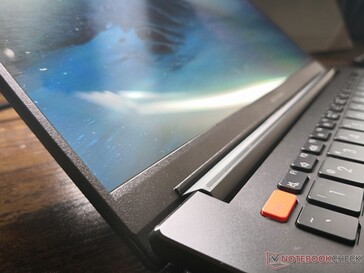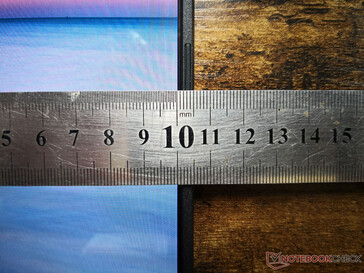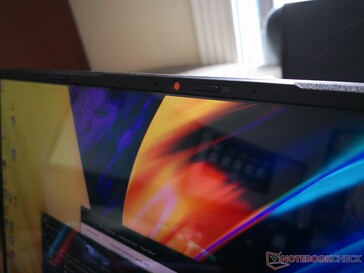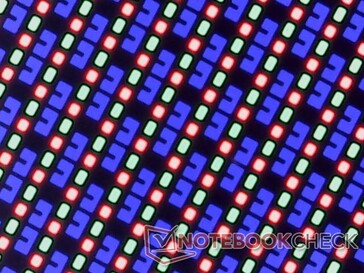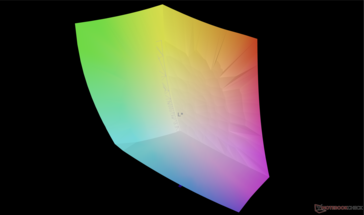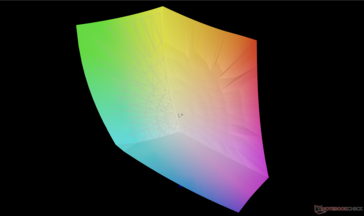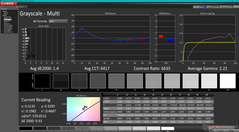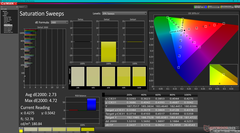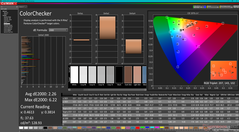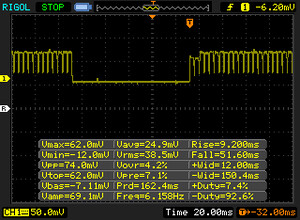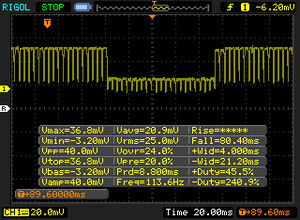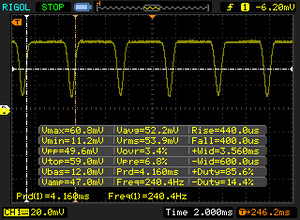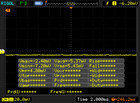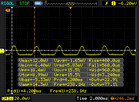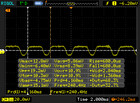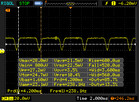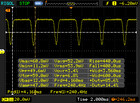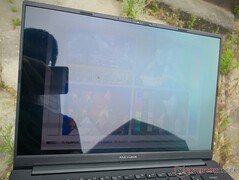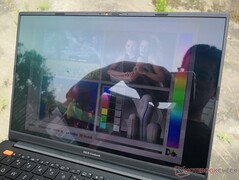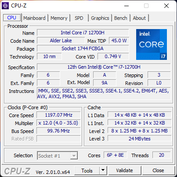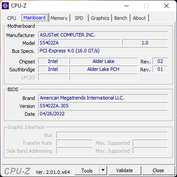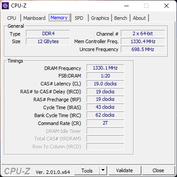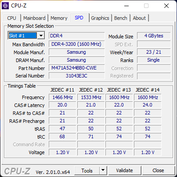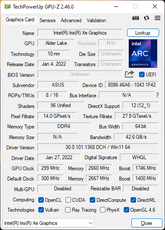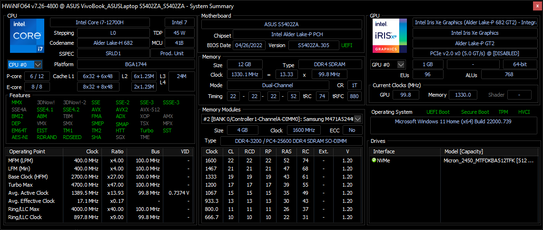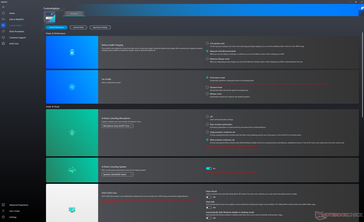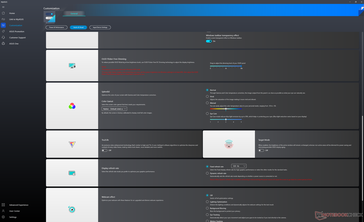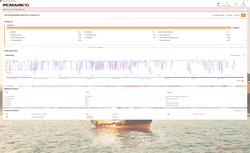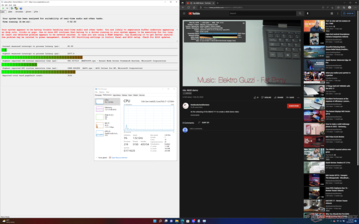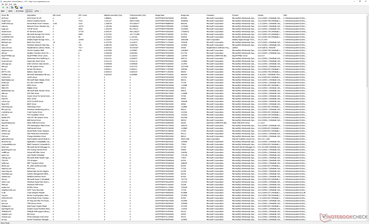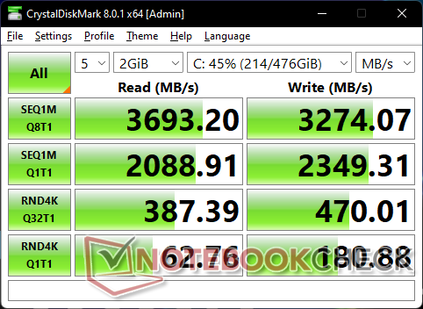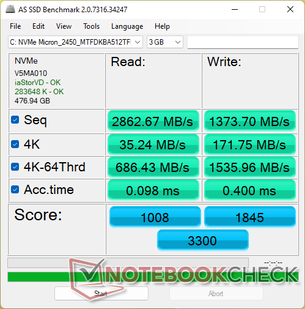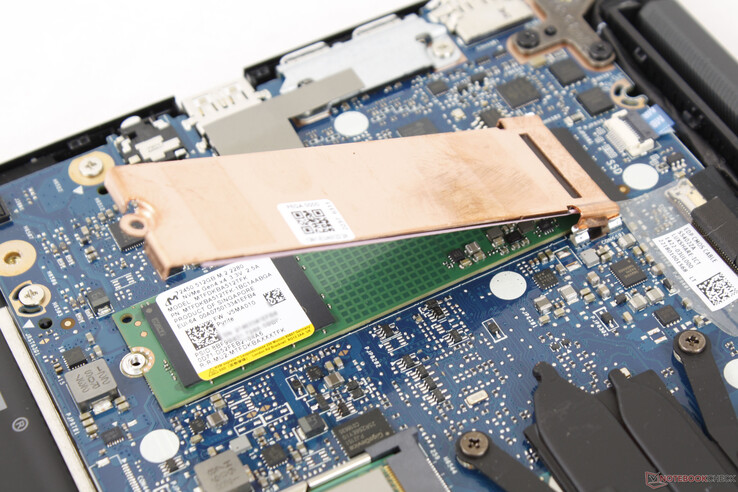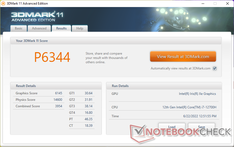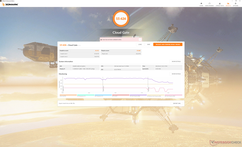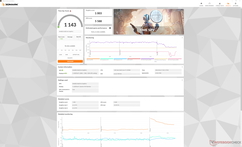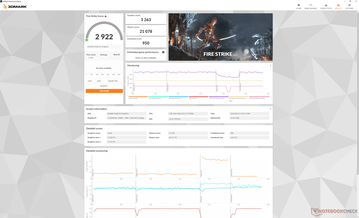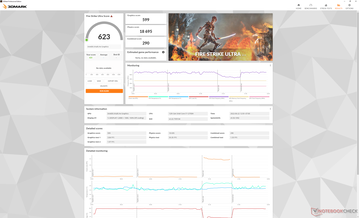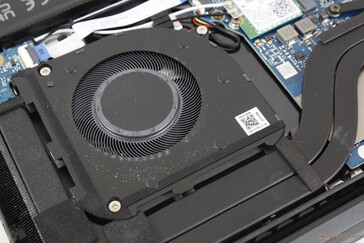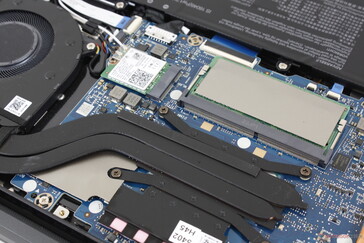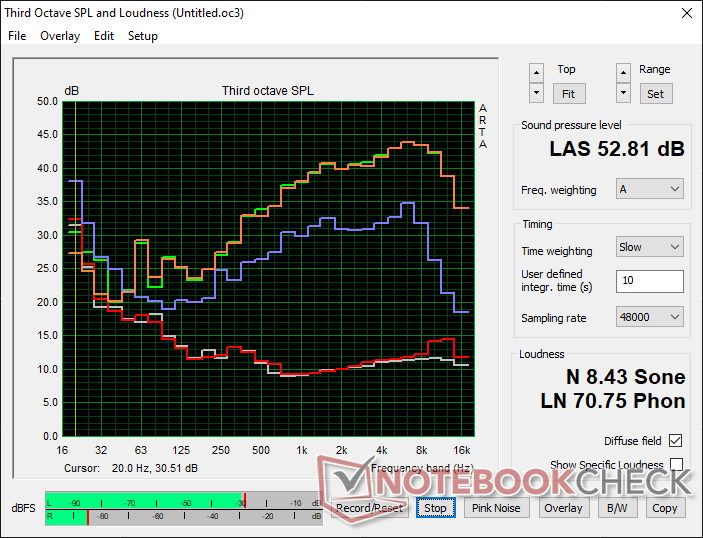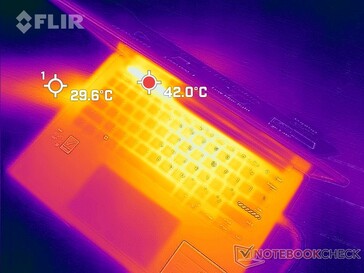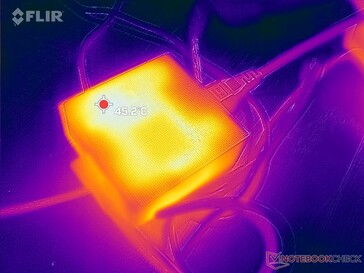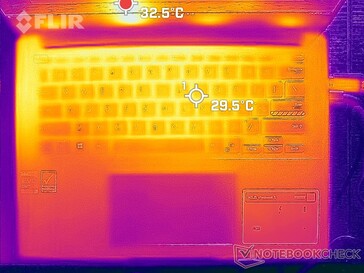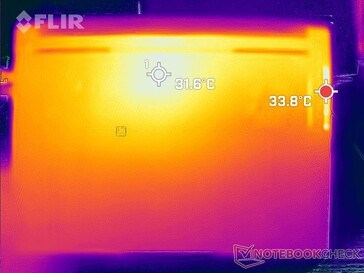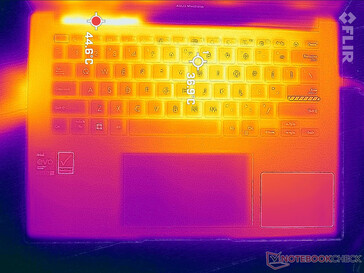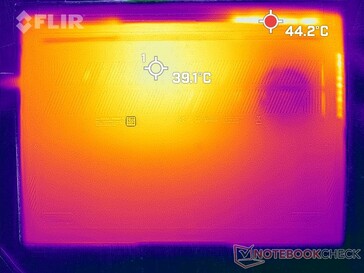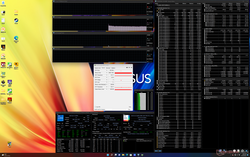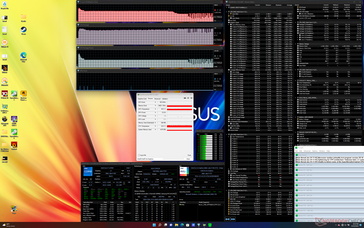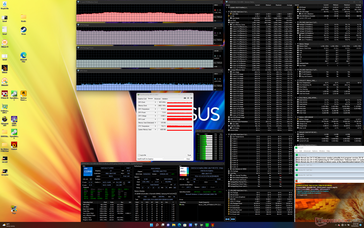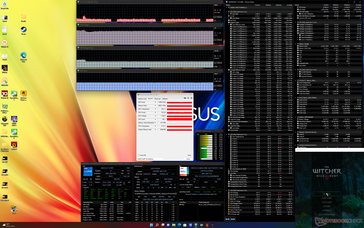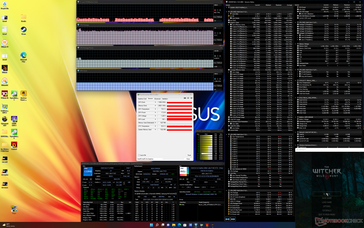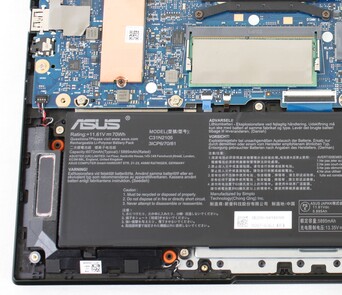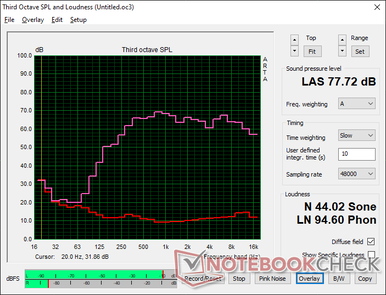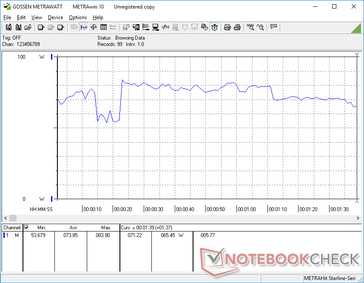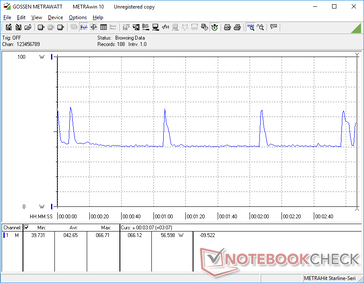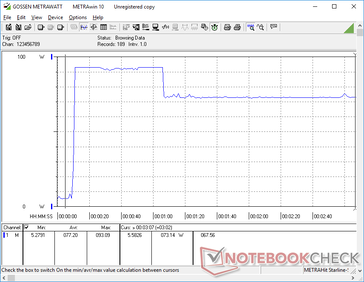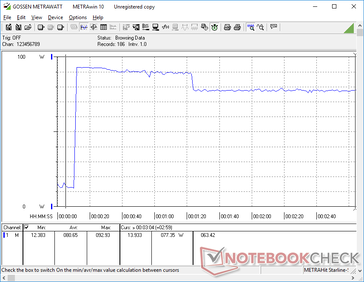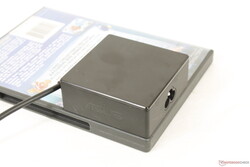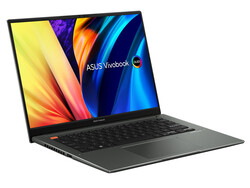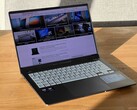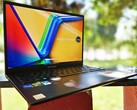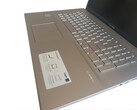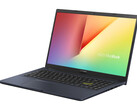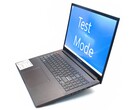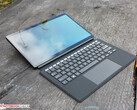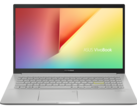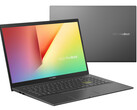Asus VivoBook S 14X S5402Z review: World's first 14.5-inch 2.8K 120 Hz OLED laptop
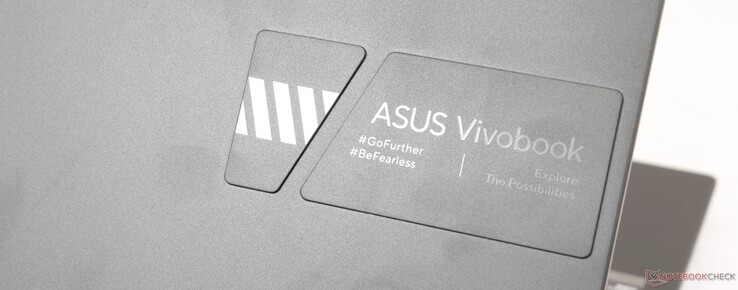
Unlike the high-end Zenbook series, the Vivobook series targets the budget to midrange market at more price-conscious configurations and features. The Vivobook S 14X, however, is unique in that it integrates relatively high-end hardware features not found on other Vivobook models including its 14.5-inch form factor, 120 Hz OLED display, a mostly aluminum chassis, and a 12th gen Core H-series CPU. Such eye-catching options could easily pass on a Zenbook model. For this review, we'll try to identify any cut corners and benchmark how well the promising hardware can perform.
Our configuration in review comes with the 14.5-inch 2.8K (2880 x 1800) 120 Hz OLED display, Core i7-12700H CPU, 12 GB of mixed RAM (soldered + removable), and 512 GB PCIe3 storage for approximately $1000 USD retail. Lesser SKUs exist with the Core i5-12500H, but they all come with the same 2.8K 16:10 display.
Alternatives to the 14.5-inch Vivobook S 14X include 14.0-inch models like the Lenovo IdeaPad 3 14, Huawei MateBook 14, HP Envy 14, or the Pavilion Plus 14. Note that many of these models ship with slower U-series CPUs whereas our Vivobook comes with H-series options.
More Asus reviews:
Potential Competitors in Comparison
Rating | Date | Model | Weight | Height | Size | Resolution | Price |
|---|---|---|---|---|---|---|---|
| 84.1 % v7 (old) | 06 / 2022 | Asus VivoBook S 14X S5402Z i7-12700H, Iris Xe G7 96EUs | 1.6 kg | 17.9 mm | 14.50" | 2880x1800 | |
| 86.3 % v7 (old) | 07 / 2022 | Asus Vivobook Pro 14 M3401QC-KM007T R5 5600H, GeForce RTX 3050 4GB Laptop GPU | 1.5 kg | 19 mm | 14.00" | 2880x1800 | |
| 79.2 % v7 (old) | 06 / 2022 | Lenovo IdeaPad 3 14ITL6 82H700CCGE Celeron 6305, UHD Graphics Xe G4 48EUs | 1.4 kg | 19.9 mm | 14.00" | 1920x1080 | |
| 87.6 % v7 (old) | 06 / 2022 | Lenovo Yoga Slim 7i Pro 14IAP G7 i5-1240P, Iris Xe G7 80EUs | 1.3 kg | 14.6 mm | 14.00" | 2880x1800 | |
| 86.9 % v7 (old) | 04 / 2022 | Huawei MateBook 14 2021 AMD R5 5500U, Vega 7 | 1.5 kg | 15.9 mm | 14.00" | 2160x1440 | |
| 86.5 % v7 (old) | 02 / 2021 | HP Envy 14-eb0010nr i5-1135G7, GeForce GTX 1650 Ti Max-Q | 1.6 kg | 17.9 mm | 14.00" | 1920x1200 |
Case — Classy New Design
Vivobook models are typically not as luxurious or strongly built as a pricier Zenbook, but this Vivobook S 14X is perhaps the closest yet for the series. The metal design looks and feels of higher quality than the older Vivobook S13 or Vivobook 14 which now seem outdated in comparison. Interestingly, Asus has dropped the ErgoLift hinges from previous generation Vivobook designs for a more standard lid that can open the full 180 degrees.
The weakest part of the Vivobook chassis is its display. Though glossy, it uses no edge-to-edge glass which typically reinforces both the screen and the lid. Thus, it's easier to twist and flex the lid on our Vivobook when compared to the stiffer lids on the Zenbook Flip 14, HP Spectre x360 14, or Dell XPS 13 — all of which have edge-to-edge glass reinforcement. The base of the laptop is otherwise stronger and much more resistant to warping than the lid. We observed similar properties on the 16-inch Vivobook Pro 16X which utilizes a very similar design language as our Vivobook S 14X.
In terms of size and weight, our Vivobook is just slightly larger and heavier than many 14-inch alternatives due to its slightly larger 14.5-inch 16:10 screen size. The 14.0-inch Matebook 14, for example, is about 100 g lighter and 7 to 15 mm smaller in length and width. That extra 0.5-inch in screen real estate doesn't come free in this regard.
Connectivity — Dual Thunderbolt 4 Ports
Port options are excellent for a 14-inch form factor. Not only are users getting full-size HDMI and two USB-A ports, but the system integrates two Thunderbolt 4 ports as well for better docking capabilities than even a Dell XPS 13. The main issue is port positioning as the ports along the right edge are packed too tightly together. The USB-A port along the left edge is 2.0 only.
Communication
| Networking | |
| iperf3 transmit AX12 | |
| HP Envy 14-eb0010nr | |
| Huawei MateBook 14 2021 AMD | |
| iperf3 receive AX12 | |
| HP Envy 14-eb0010nr | |
| Huawei MateBook 14 2021 AMD | |
| iperf3 receive AXE11000 6GHz | |
| Asus VivoBook S 14X S5402Z | |
| Asus Vivobook Pro 14 M3401QC-KM007T | |
| Lenovo IdeaPad 3 14ITL6 82H700CCGE | |
| iperf3 transmit AXE11000 6GHz | |
| Asus VivoBook S 14X S5402Z | |
| Asus Vivobook Pro 14 M3401QC-KM007T | |
| Lenovo IdeaPad 3 14ITL6 82H700CCGE | |
Webcam
Camera quality is the typical 720p for both poor quality and colors. There is no IR or Windows Hello support.
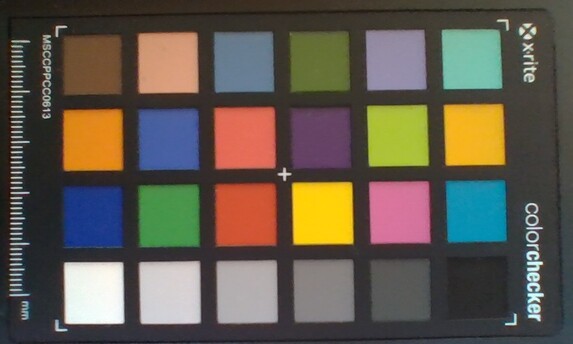
Maintenance
Accessories and Warranty
There are no extras in the box other than the AC adapter and paperwork. The standard one-year limited warranty applies if purchased in the US.
Input Devices
Keyboard
The keyboard is more comfortable to type on than on a Lenovo IdeaPad or Dell Inspiron as the keys here have sharper and more satisfying feedback when pressed. Clatter is a bit louder than usual as a result of the stronger feedback.
Touchpad
The clickpad (13 x 7.5 cm) is larger than the ones on the IdeaPad 5 Pro 14 (10.5 x 7 cm) or Dell Inspiron 14 7420 (11.5 x 8 cm) to be very spacious for a 14-inch form factor. Traction is smoother than the surrounding palm rests with noticeable sticking only when gliding at slower speeds for easier clicking. However, a key drawback to the smooth matte plastic surface is that it is prone to unsightly fingerprint buildup over time. The silver color chassis option may be able to hide fingerprints better.
Feedback when clicking on the clickpad is unfortunately weak and with very shallow travel for an unsatisfying experience. Such an attribute is common amongst midrange or cheaper Ultrabooks with no dedicated mouse buttons. It's definitely recommended to use an external mouse if available.
Display — Ultra Smooth 120 Hz OLED
The 14.5-inch Vivobook S 14X comes with the exact same high quality Samsung ATNA45AF01-0 OLED panel as found on the 14.5-inch Zenbook Pro 14 Duo. Thus, both models share similar attributes and viewing experiences including the 120 Hz native refresh rate, deep black levels, full DCI-P3 color range, nearly instant black-white response times, and extremely uniform brightness distribution. Both even share the same flickering frequency of 240 Hz that's present on all brightness levels. The MyAsus software includes tools to reduce the intensity of the flickering, but they all involve dimming the panel in some way. If your eyes are sensitive to onscreen flickering, then it may be best to avoid using the laptop at high brightness levels.
Speaking of brightness levels, Asus advertises a maximum brightness of 600 nits. What the manufacturer doesn't make clear, however, is that this maximum rating can only be reached when playing HDR media in HDR mode. Otherwise, maximum brightness will be limited to just ~370 nits. If your tasks, apps, or games support SDR only, then you will not be able to reach the maximum 600-nit rating. The advertisement can therefore be a little misleading.
There are no other 14-inch laptops with 120 Hz OLED panels currently in the market outside of these two Asus Vivobook and Zenbook models. Aside from the unavoidable flickering, these OLED panels offer some of the best picture quality in the subnotebook category.
| |||||||||||||||||||||||||
Brightness Distribution: 99 %
Center on Battery: 373 cd/m²
Contrast: ∞:1 (Black: 0 cd/m²)
ΔE ColorChecker Calman: 2.26 | ∀{0.5-29.43 Ø4.78}
ΔE Greyscale Calman: 1.4 | ∀{0.09-98 Ø5}
95.5% AdobeRGB 1998 (Argyll 3D)
100% sRGB (Argyll 3D)
99.9% Display P3 (Argyll 3D)
Gamma: 2.22
CCT: 6417 K
| Asus VivoBook S 14X S5402Z Samsung ATNA45AF01-0, OLED, 2880x1800, 14.5" | Asus Vivobook Pro 14 M3401QC-KM007T SAMSUNG: SDC4171, OLED, 2880x1800, 14" | Lenovo IdeaPad 3 14ITL6 82H700CCGE AU Optronics B140HAN04.E, IPS, 1920x1080, 14" | Lenovo Yoga Slim 7i Pro 14IAP G7 LEN140WQ+, IPS, 2880x1800, 14" | Huawei MateBook 14 2021 AMD TV140WTM-NH0, IPS, 2160x1440, 14" | HP Envy 14-eb0010nr AU Optronics AUOF392, IPS, 1920x1200, 14" | |
|---|---|---|---|---|---|---|
| Display | -0% | -56% | -13% | -23% | -14% | |
| Display P3 Coverage (%) | 99.9 | 99.41 0% | 36.6 -63% | 77.7 -22% | 65.9 -34% | 77.1 -23% |
| sRGB Coverage (%) | 100 | 99.94 0% | 54.7 -45% | 100 0% | 92.8 -7% | 99.8 0% |
| AdobeRGB 1998 Coverage (%) | 95.5 | 94.79 -1% | 37.8 -60% | 78.4 -18% | 68.2 -29% | 76.7 -20% |
| Response Times | -256% | -4314% | -3191% | -4279% | -6392% | |
| Response Time Grey 50% / Grey 80% * (ms) | 0.73 ? | 3 ? -311% | 44 ? -5927% | 35.2 ? -4722% | 43.2 ? -5818% | 61.2 ? -8284% |
| Response Time Black / White * (ms) | 1 ? | 3 ? -200% | 28 ? -2700% | 17.6 ? -1660% | 28.4 ? -2740% | 46 ? -4500% |
| PWM Frequency (Hz) | 240.4 ? | 360 | ||||
| Screen | 16% | -101% | -23% | 8% | 1% | |
| Brightness middle (cd/m²) | 373 | 384 3% | 368 -1% | 469 26% | 457 23% | 412 10% |
| Brightness (cd/m²) | 375 | 385 3% | 332 -11% | 445 19% | 451 20% | 392 5% |
| Brightness Distribution (%) | 99 | 98 -1% | 83 -16% | 90 -9% | 93 -6% | 81 -18% |
| Black Level * (cd/m²) | 0.07 | 0.47 | 0.26 | 0.32 | ||
| Colorchecker dE 2000 * | 2.26 | 1.75 23% | 6.14 -172% | 3.5 -55% | 1.9 16% | 1.88 17% |
| Colorchecker dE 2000 max. * | 6.22 | 3.41 45% | 17.76 -186% | 5.3 15% | 3.1 50% | 3.06 51% |
| Greyscale dE 2000 * | 1.4 | 1.06 24% | 4.44 -217% | 3.3 -136% | 2.2 -57% | 2.2 -57% |
| Gamma | 2.22 99% | 2.39 92% | 2.73 81% | 1.97 112% | 2.14 103% | 2.1 105% |
| CCT | 6417 101% | 6440 101% | 5979 109% | 6512 100% | 6921 94% | 6650 98% |
| Contrast (:1) | 5486 | 783 | 1758 | 1288 | ||
| Colorchecker dE 2000 calibrated * | 2.32 | 1.7 | 1.96 | |||
| Color Space (Percent of AdobeRGB 1998) (%) | 68.7 | |||||
| Color Space (Percent of sRGB) (%) | 99.8 | |||||
| Total Average (Program / Settings) | -80% /
-38% | -1490% /
-854% | -1076% /
-597% | -1431% /
-780% | -2135% /
-1165% |
* ... smaller is better
Asus advertises a Pantone Validated display meaning accurate colors against the DCI-P3 standard. We're able to independently confirm the accurate colors with an X-Rite colorimeter as average DeltaE values are indeed very low across the board. Of all the tested colors, however, red appears to deviate the most with a DeltaE of 7.68 or approximately 3x to 4x the average.
Display Response Times
| ↔ Response Time Black to White | ||
|---|---|---|
| 1 ms ... rise ↗ and fall ↘ combined | ↗ 0.5 ms rise | |
| ↘ 0.5 ms fall | ||
| The screen shows very fast response rates in our tests and should be very well suited for fast-paced gaming. In comparison, all tested devices range from 0.1 (minimum) to 240 (maximum) ms. » 3 % of all devices are better. This means that the measured response time is better than the average of all tested devices (20.2 ms). | ||
| ↔ Response Time 50% Grey to 80% Grey | ||
| 0.73 ms ... rise ↗ and fall ↘ combined | ↗ 0.37 ms rise | |
| ↘ 0.36 ms fall | ||
| The screen shows very fast response rates in our tests and should be very well suited for fast-paced gaming. In comparison, all tested devices range from 0.165 (minimum) to 636 (maximum) ms. » 2 % of all devices are better. This means that the measured response time is better than the average of all tested devices (31.6 ms). | ||
Screen Flickering / PWM (Pulse-Width Modulation)
| Screen flickering / PWM detected | 240.4 Hz | ≤ 100 % brightness setting | |
The display backlight flickers at 240.4 Hz (worst case, e.g., utilizing PWM) Flickering detected at a brightness setting of 100 % and below. There should be no flickering or PWM above this brightness setting. The frequency of 240.4 Hz is relatively low, so sensitive users will likely notice flickering and experience eyestrain at the stated brightness setting and below. In comparison: 53 % of all tested devices do not use PWM to dim the display. If PWM was detected, an average of 8118 (minimum: 5 - maximum: 343500) Hz was measured. | |||
Outdoor visibility is not great under most conditions due to the glossy overlay and moderate brightness. Since most content is SDR and not HDR, users will only be getting a brightness of just ~370 nits instead of the 600 nit maximum in most scenarios. You'll want to work under shade whenever possible to reduce the glare.
Viewing angles are wider than IPS as OLED panels don't exhibit the same grayscale degradations from extreme angles. The unique rainbow effect is still present, however, much like on the OLED display of the Zenbook Flip 15.
Performance — Intel 12th gen Core H Processor
Testing Conditions
We set our unit to Performance mode via Windows and the MyAsus software prior to benchmarking for the highest possible scores. It's recommended that owners become familiar with the Asus software as key features related to performance, battery, display, and updates are all toggled here.
Processor
CPU performance is a mixed bag. When compared to the average laptop equipped with the same Core i7-12700H CPU, the processor in our Vivobook S 14X is about 20 percent slower. When compared to other similarly-sized 14-inch Ultrabooks running on Core U-series CPUs, however, our Asus is significantly faster. The Core i7-1165G7 in the Zenbook 14, for example, is 50 percent slower in multi-threaded workloads and the differences only become greater if comparing models running on 10th gen Ice Lake or Comet Lake-U CPUs. Thus, while the Core i7-12700H here could certainly be faster, it is arguably already very fast for a 14-inch form factor.
This same Core i7-12700H CPU can be found on many ultrathin gaming laptops such as the Schenker XMG Neo 15 to give an idea of how much performance is stuffed onto the Vivobook S 14X.
Cinebench R15 Multi Loop
Cinebench R23: Multi Core | Single Core
Cinebench R15: CPU Multi 64Bit | CPU Single 64Bit
Blender: v2.79 BMW27 CPU
7-Zip 18.03: 7z b 4 | 7z b 4 -mmt1
Geekbench 5.5: Multi-Core | Single-Core
HWBOT x265 Benchmark v2.2: 4k Preset
LibreOffice : 20 Documents To PDF
R Benchmark 2.5: Overall mean
Cinebench R23: Multi Core | Single Core
Cinebench R15: CPU Multi 64Bit | CPU Single 64Bit
Blender: v2.79 BMW27 CPU
7-Zip 18.03: 7z b 4 | 7z b 4 -mmt1
Geekbench 5.5: Multi-Core | Single-Core
HWBOT x265 Benchmark v2.2: 4k Preset
LibreOffice : 20 Documents To PDF
R Benchmark 2.5: Overall mean
* ... smaller is better
AIDA64: FP32 Ray-Trace | FPU Julia | CPU SHA3 | CPU Queen | FPU SinJulia | FPU Mandel | CPU AES | CPU ZLib | FP64 Ray-Trace | CPU PhotoWorxx
| Performance rating | |
| Average Intel Core i7-12700H | |
| Asus Vivobook Pro 14 M3401QC-KM007T | |
| Huawei MateBook 14 2021 AMD | |
| Asus VivoBook S 14X S5402Z | |
| Lenovo Yoga Slim 7i Pro 14IAP G7 | |
| Lenovo IdeaPad 3 14ITL6 82H700CCGE | |
| AIDA64 / FP32 Ray-Trace | |
| Asus Vivobook Pro 14 M3401QC-KM007T | |
| Average Intel Core i7-12700H (2585 - 17957, n=63) | |
| Huawei MateBook 14 2021 AMD | |
| Asus VivoBook S 14X S5402Z | |
| Lenovo Yoga Slim 7i Pro 14IAP G7 | |
| Lenovo IdeaPad 3 14ITL6 82H700CCGE | |
| AIDA64 / FPU Julia | |
| Asus Vivobook Pro 14 M3401QC-KM007T | |
| Huawei MateBook 14 2021 AMD | |
| Average Intel Core i7-12700H (12439 - 90760, n=63) | |
| Asus VivoBook S 14X S5402Z | |
| Lenovo Yoga Slim 7i Pro 14IAP G7 | |
| Lenovo IdeaPad 3 14ITL6 82H700CCGE | |
| AIDA64 / CPU SHA3 | |
| Average Intel Core i7-12700H (833 - 4242, n=63) | |
| Asus VivoBook S 14X S5402Z | |
| Asus Vivobook Pro 14 M3401QC-KM007T | |
| Lenovo Yoga Slim 7i Pro 14IAP G7 | |
| Huawei MateBook 14 2021 AMD | |
| Lenovo IdeaPad 3 14ITL6 82H700CCGE | |
| AIDA64 / CPU Queen | |
| Average Intel Core i7-12700H (57923 - 103202, n=63) | |
| Asus VivoBook S 14X S5402Z | |
| Lenovo Yoga Slim 7i Pro 14IAP G7 | |
| Asus Vivobook Pro 14 M3401QC-KM007T | |
| Huawei MateBook 14 2021 AMD | |
| Lenovo IdeaPad 3 14ITL6 82H700CCGE | |
| AIDA64 / FPU SinJulia | |
| Huawei MateBook 14 2021 AMD | |
| Average Intel Core i7-12700H (3249 - 9939, n=63) | |
| Asus Vivobook Pro 14 M3401QC-KM007T | |
| Asus VivoBook S 14X S5402Z | |
| Lenovo Yoga Slim 7i Pro 14IAP G7 | |
| Lenovo IdeaPad 3 14ITL6 82H700CCGE | |
| AIDA64 / FPU Mandel | |
| Asus Vivobook Pro 14 M3401QC-KM007T | |
| Huawei MateBook 14 2021 AMD | |
| Average Intel Core i7-12700H (7135 - 44760, n=63) | |
| Asus VivoBook S 14X S5402Z | |
| Lenovo Yoga Slim 7i Pro 14IAP G7 | |
| Lenovo IdeaPad 3 14ITL6 82H700CCGE | |
| AIDA64 / CPU AES | |
| Asus Vivobook Pro 14 M3401QC-KM007T | |
| Average Intel Core i7-12700H (31839 - 144360, n=63) | |
| Huawei MateBook 14 2021 AMD | |
| Asus VivoBook S 14X S5402Z | |
| Lenovo Yoga Slim 7i Pro 14IAP G7 | |
| Lenovo IdeaPad 3 14ITL6 82H700CCGE | |
| AIDA64 / CPU ZLib | |
| Average Intel Core i7-12700H (305 - 1171, n=63) | |
| Asus VivoBook S 14X S5402Z | |
| Lenovo Yoga Slim 7i Pro 14IAP G7 | |
| Huawei MateBook 14 2021 AMD | |
| Asus Vivobook Pro 14 M3401QC-KM007T | |
| Lenovo IdeaPad 3 14ITL6 82H700CCGE | |
| AIDA64 / FP64 Ray-Trace | |
| Average Intel Core i7-12700H (1437 - 9692, n=63) | |
| Asus Vivobook Pro 14 M3401QC-KM007T | |
| Huawei MateBook 14 2021 AMD | |
| Asus VivoBook S 14X S5402Z | |
| Lenovo Yoga Slim 7i Pro 14IAP G7 | |
| Lenovo IdeaPad 3 14ITL6 82H700CCGE | |
| AIDA64 / CPU PhotoWorxx | |
| Lenovo Yoga Slim 7i Pro 14IAP G7 | |
| Average Intel Core i7-12700H (12863 - 52207, n=63) | |
| Huawei MateBook 14 2021 AMD | |
| Asus Vivobook Pro 14 M3401QC-KM007T | |
| Asus VivoBook S 14X S5402Z | |
| Lenovo IdeaPad 3 14ITL6 82H700CCGE | |
System Performance
PCMark results are generally higher than other 14-inch Ultrabooks powered by U-series CPUs but not by significant margins. While the Core i7-12700H is much faster than any U-series alternative on paper, the overall responsiveness of most daily applications is only marginally faster in practice.
CrossMark: Overall | Productivity | Creativity | Responsiveness
| PCMark 10 / Score | |
| Average Intel Core i7-12700H, Intel Iris Xe Graphics G7 96EUs (5541 - 6281, n=8) | |
| Asus Vivobook Pro 14 M3401QC-KM007T | |
| Asus VivoBook S 14X S5402Z | |
| HP Envy 14-eb0010nr | |
| Lenovo Yoga Slim 7i Pro 14IAP G7 | |
| Huawei MateBook 14 2021 AMD | |
| Lenovo IdeaPad 3 14ITL6 82H700CCGE | |
| PCMark 10 / Essentials | |
| Average Intel Core i7-12700H, Intel Iris Xe Graphics G7 96EUs (9991 - 11699, n=8) | |
| Asus VivoBook S 14X S5402Z | |
| Lenovo Yoga Slim 7i Pro 14IAP G7 | |
| Asus Vivobook Pro 14 M3401QC-KM007T | |
| Huawei MateBook 14 2021 AMD | |
| HP Envy 14-eb0010nr | |
| Lenovo IdeaPad 3 14ITL6 82H700CCGE | |
| PCMark 10 / Productivity | |
| HP Envy 14-eb0010nr | |
| Asus Vivobook Pro 14 M3401QC-KM007T | |
| Huawei MateBook 14 2021 AMD | |
| Average Intel Core i7-12700H, Intel Iris Xe Graphics G7 96EUs (6690 - 8038, n=8) | |
| Asus VivoBook S 14X S5402Z | |
| Lenovo Yoga Slim 7i Pro 14IAP G7 | |
| Lenovo IdeaPad 3 14ITL6 82H700CCGE | |
| PCMark 10 / Digital Content Creation | |
| Asus Vivobook Pro 14 M3401QC-KM007T | |
| Average Intel Core i7-12700H, Intel Iris Xe Graphics G7 96EUs (6207 - 7401, n=8) | |
| Asus VivoBook S 14X S5402Z | |
| Lenovo Yoga Slim 7i Pro 14IAP G7 | |
| HP Envy 14-eb0010nr | |
| Huawei MateBook 14 2021 AMD | |
| Lenovo IdeaPad 3 14ITL6 82H700CCGE | |
| CrossMark / Overall | |
| Average Intel Core i7-12700H, Intel Iris Xe Graphics G7 96EUs (1492 - 1907, n=8) | |
| Lenovo Yoga Slim 7i Pro 14IAP G7 | |
| Asus VivoBook S 14X S5402Z | |
| Asus Vivobook Pro 14 M3401QC-KM007T | |
| Huawei MateBook 14 2021 AMD | |
| Lenovo IdeaPad 3 14ITL6 82H700CCGE | |
| CrossMark / Productivity | |
| Average Intel Core i7-12700H, Intel Iris Xe Graphics G7 96EUs (1499 - 1832, n=8) | |
| Asus VivoBook S 14X S5402Z | |
| Lenovo Yoga Slim 7i Pro 14IAP G7 | |
| Asus Vivobook Pro 14 M3401QC-KM007T | |
| Huawei MateBook 14 2021 AMD | |
| Lenovo IdeaPad 3 14ITL6 82H700CCGE | |
| CrossMark / Creativity | |
| Average Intel Core i7-12700H, Intel Iris Xe Graphics G7 96EUs (1507 - 2016, n=8) | |
| Lenovo Yoga Slim 7i Pro 14IAP G7 | |
| Asus VivoBook S 14X S5402Z | |
| Asus Vivobook Pro 14 M3401QC-KM007T | |
| Huawei MateBook 14 2021 AMD | |
| Lenovo IdeaPad 3 14ITL6 82H700CCGE | |
| CrossMark / Responsiveness | |
| Average Intel Core i7-12700H, Intel Iris Xe Graphics G7 96EUs (1384 - 1831, n=8) | |
| Asus VivoBook S 14X S5402Z | |
| Lenovo Yoga Slim 7i Pro 14IAP G7 | |
| Asus Vivobook Pro 14 M3401QC-KM007T | |
| Huawei MateBook 14 2021 AMD | |
| Lenovo IdeaPad 3 14ITL6 82H700CCGE | |
| PCMark 10 Score | 5726 points | |
Help | ||
| AIDA64 / Memory Copy | |
| Lenovo Yoga Slim 7i Pro 14IAP G7 | |
| Average Intel Core i7-12700H (25615 - 80511, n=63) | |
| Asus Vivobook Pro 14 M3401QC-KM007T | |
| Huawei MateBook 14 2021 AMD | |
| Asus VivoBook S 14X S5402Z | |
| Lenovo IdeaPad 3 14ITL6 82H700CCGE | |
| AIDA64 / Memory Read | |
| Lenovo Yoga Slim 7i Pro 14IAP G7 | |
| Average Intel Core i7-12700H (25586 - 79442, n=63) | |
| Huawei MateBook 14 2021 AMD | |
| Asus Vivobook Pro 14 M3401QC-KM007T | |
| Asus VivoBook S 14X S5402Z | |
| Lenovo IdeaPad 3 14ITL6 82H700CCGE | |
| AIDA64 / Memory Write | |
| Lenovo Yoga Slim 7i Pro 14IAP G7 | |
| Average Intel Core i7-12700H (23679 - 88660, n=63) | |
| Asus Vivobook Pro 14 M3401QC-KM007T | |
| Huawei MateBook 14 2021 AMD | |
| Asus VivoBook S 14X S5402Z | |
| Lenovo IdeaPad 3 14ITL6 82H700CCGE | |
| AIDA64 / Memory Latency | |
| Lenovo IdeaPad 3 14ITL6 82H700CCGE | |
| Huawei MateBook 14 2021 AMD | |
| Asus Vivobook Pro 14 M3401QC-KM007T | |
| Average Intel Core i7-12700H (76.2 - 133.9, n=61) | |
| Asus VivoBook S 14X S5402Z | |
* ... smaller is better
DPC Latency
| DPC Latencies / LatencyMon - interrupt to process latency (max), Web, Youtube, Prime95 | |
| HP Envy 14-eb0010nr | |
| Asus VivoBook S 14X S5402Z | |
| Lenovo IdeaPad 3 14ITL6 82H700CCGE | |
| Asus Vivobook Pro 14 M3401QC-KM007T | |
| Lenovo Yoga Slim 7i Pro 14IAP G7 | |
| Huawei MateBook 14 2021 AMD | |
* ... smaller is better
Storage Devices
Our unit comes equipped with the 512 GB Micron MTFDKBA512TFK PCIe3 x4 NVMe SSD capable of sequential read and write rates of 3500 MB/s and 3000 MB/s, respectively. It's one of the faster PCIe3 x4 NVMe SSDs available which pairs well with the midrange Vivobook brand. The drive in our unit exhibits no issues maintaining maximum transfer rates when stressed for extended periods.
The MSI Pulse GL66 gaming laptop comes equipped with the exact same 512 GB Micron 2450 SSD.
* ... smaller is better
Disk Throttling: DiskSpd Read Loop, Queue Depth 8
GPU Performance
The integrated Iris Xe 96 EUs in our test unit returns disappointing results that are 30 percent slower than the average Iris Xe 96 EUs in our database. This performance deficit usually happens when RAM is slow and/or running in single-channel mode instead of dual-channel mode. The asymmetric RAM configuration of our unit (4 GB removable + 8 GB soldered) is the likely culprit of the relatively poor GPU performance. Though a bit of light gaming is possible at sub 1080p settings, it shouldn't be the primary application for this Vivobook.
Raw GPU performance is still significantly faster than the much older UHD Graphics 620 that was common on Ultrabooks prior to the Intel 10th gen CPU series.
| 3DMark 11 Performance | 6344 points | |
| 3DMark Cloud Gate Standard Score | 15626 points | |
| 3DMark Fire Strike Score | 2922 points | |
| 3DMark Time Spy Score | 1143 points | |
Help | ||
| Cyberpunk 2077 1.6 | |
| 1920x1080 Low Preset | |
| Lenovo Yoga 9 14IAP7 82LU0001US | |
| Average Intel Iris Xe Graphics G7 96EUs (13 - 25.9, n=42) | |
| Asus VivoBook S 14X S5402Z | |
| 1920x1080 Medium Preset | |
| Lenovo Yoga 9 14IAP7 82LU0001US | |
| Average Intel Iris Xe Graphics G7 96EUs (10.8 - 21.7, n=37) | |
| Asus VivoBook S 14X S5402Z | |
| 1920x1080 High Preset | |
| Lenovo Yoga 9 14IAP7 82LU0001US | |
| Average Intel Iris Xe Graphics G7 96EUs (9.8 - 16.9, n=34) | |
| Asus VivoBook S 14X S5402Z | |
| 1920x1080 Ultra Preset | |
| Lenovo Yoga 9 14IAP7 82LU0001US | |
| Average Intel Iris Xe Graphics G7 96EUs (7.4 - 16.8, n=32) | |
| Asus VivoBook S 14X S5402Z | |
Witcher 3 FPS Chart
| low | med. | high | ultra | QHD | |
|---|---|---|---|---|---|
| GTA V (2015) | 78.1 | 51.9 | 11.8 | 4.24 | |
| The Witcher 3 (2015) | 67.5 | 39.6 | 17.8 | 9.6 | |
| Dota 2 Reborn (2015) | 106.4 | 74.6 | 43.2 | 40 | |
| Final Fantasy XV Benchmark (2018) | 28.2 | 14.3 | 10.6 | 7.31 | |
| X-Plane 11.11 (2018) | 48.7 | 38.8 | 34.9 | ||
| Strange Brigade (2018) | 77.4 | 26.2 | 22.2 | 17.9 | |
| Cyberpunk 2077 1.6 (2022) | 14.6 | 11.7 | 9.8 | 8 |
Emissions
System Noise — Loud Under Load
Fan noise is louder than on most U-series-powered Ultrabooks to be closer to models with discrete graphics like the Envy 14 or Vivobook Pro 14. When running 3DMark 06 on Balanced mode to represent average load, for example, fan noise would be as loud as 43 dB(A) compared to just 27 dB(A) or 32 dB(A) on the Lenovo IdeaPad 3 14 or Matebook 14, respectively. Fan behavior is highly dependent on the three fan profiles via MyAsus (Whisper, Balanced, and Performance) and so we recommend Whisper mode if web browsing or video streaming. Otherwise, the fan will pulse frequently between 23 and 27 dB(A) or higher during undemanding loads.
When gaming on Balanced mode, fan noise would cycle between 39 and 43 dB(A). If set to Performance mode, fan noise would be significantly louder at 53 dB(A). Performance mode is necessary for extracting more power from the CPU as our Stress Test section below will show.
Noise level
| Idle |
| 23.2 / 23.2 / 27.2 dB(A) |
| Load |
| 43.2 / 52.8 dB(A) |
 | ||
30 dB silent 40 dB(A) audible 50 dB(A) loud |
||
min: | ||
| Asus VivoBook S 14X S5402Z Iris Xe G7 96EUs, i7-12700H, Micron 2450 512GB MTFDKBA512TFK | Asus Vivobook Pro 14 M3401QC-KM007T GeForce RTX 3050 4GB Laptop GPU, R5 5600H, Intel SSD 670p SSDPEKNU512GZ | Lenovo IdeaPad 3 14ITL6 82H700CCGE UHD Graphics Xe G4 48EUs, Celeron 6305, SK Hynix BC711 HFM128GD3HX015N | Lenovo Yoga Slim 7i Pro 14IAP G7 Iris Xe G7 80EUs, i5-1240P, Samsung PM9A1 MZVL2512HCJQ | Huawei MateBook 14 2021 AMD Vega 7, R5 5500U, Phison PS5013 311CD0512GB | HP Envy 14-eb0010nr GeForce GTX 1650 Ti Max-Q, i5-1135G7, Samsung SSD PM981a MZVLB256HBHQ | |
|---|---|---|---|---|---|---|
| Noise | -13% | 5% | 8% | 12% | 4% | |
| off / environment * (dB) | 22.7 | 25.4 -12% | 25.4 -12% | 23.7 -4% | 24.1 -6% | 25.9 -14% |
| Idle Minimum * (dB) | 23.2 | 25.4 -9% | 25.4 -9% | 23.7 -2% | 24.1 -4% | 26 -12% |
| Idle Average * (dB) | 23.2 | 25.4 -9% | 25.4 -9% | 25.1 -8% | 24.1 -4% | 26 -12% |
| Idle Maximum * (dB) | 27.2 | 30.9 -14% | 25.4 7% | 25.1 8% | 24.1 11% | 26 4% |
| Load Average * (dB) | 43.2 | 56 -30% | 27.2 37% | 38.4 11% | 31.8 26% | 34.9 19% |
| Witcher 3 ultra * (dB) | 52.8 | 38.4 27% | 34.6 34% | 34.5 35% | ||
| Load Maximum * (dB) | 52.8 | 56 -6% | 44.8 15% | 39.4 25% | 38.1 28% | 48.7 8% |
* ... smaller is better
Temperature
Surface temperatures are cooler than expected even after accounting for the more powerful Core H-series CPU. When running stressful loads for long periods, hot spots on our Asus can reach 37 C and 39 C on the top and bottom, respectively, compared to 41 C and 45 C on the HP Envy 14 or 43 C and 49 C on the Huawei Matebook 14. The palm rests and frontal areas remain cooler than the rear areas.
(+) The maximum temperature on the upper side is 37.2 °C / 99 F, compared to the average of 36.9 °C / 98 F, ranging from 21.1 to 71 °C for the class Multimedia.
(+) The bottom heats up to a maximum of 39.2 °C / 103 F, compared to the average of 39.2 °C / 103 F
(+) In idle usage, the average temperature for the upper side is 28.5 °C / 83 F, compared to the device average of 31.3 °C / 88 F.
(+) The palmrests and touchpad are cooler than skin temperature with a maximum of 29.8 °C / 85.6 F and are therefore cool to the touch.
(±) The average temperature of the palmrest area of similar devices was 28.7 °C / 83.7 F (-1.1 °C / -1.9 F).
| Asus VivoBook S 14X S5402Z Intel Core i7-12700H, Intel Iris Xe Graphics G7 96EUs | Asus Vivobook Pro 14 M3401QC-KM007T AMD Ryzen 5 5600H, NVIDIA GeForce RTX 3050 4GB Laptop GPU | Lenovo IdeaPad 3 14ITL6 82H700CCGE Intel Celeron 6305, Intel UHD Graphics Xe G4 48EUs | Lenovo Yoga Slim 7i Pro 14IAP G7 Intel Core i5-1240P, Intel Iris Xe Graphics G7 80EUs | Huawei MateBook 14 2021 AMD AMD Ryzen 5 5500U, AMD Radeon RX Vega 7 | HP Envy 14-eb0010nr Intel Core i5-1135G7, NVIDIA GeForce GTX 1650 Ti Max-Q | |
|---|---|---|---|---|---|---|
| Heat | -19% | -6% | -8% | -1% | -13% | |
| Maximum Upper Side * (°C) | 37.2 | 42.3 -14% | 38.6 -4% | 42.3 -14% | 42.8 -15% | 41.2 -11% |
| Maximum Bottom * (°C) | 39.2 | 49.6 -27% | 41 -5% | 52.8 -35% | 48.8 -24% | 45.6 -16% |
| Idle Upper Side * (°C) | 30.4 | 34.2 -13% | 32.6 -7% | 27.1 11% | 25.2 17% | 31.8 -5% |
| Idle Bottom * (°C) | 31.6 | 37.9 -20% | 33.9 -7% | 29.1 8% | 25.9 18% | 37.8 -20% |
* ... smaller is better
Stress Test
When the CPU is stressed under Prime95, clock rates would boost to 4 GHz for a couple of seconds before quickly reaching a core temperature of 94 C. Performance and temperature would then steadily decline to 3 GHz and 84 C, respectively, before finally throttling even further to 1.3 to 2.3 GHz as shown by the screenshot below. CPU package power would be as high as 80 W during the start of the test before finally cycling between 27 W and 49 W due to thermal limitations. Temperatures can reach over 90 C which is noticeably warmer than models like the HP Envy 14 or Razer Blade Stealth when under similar conditions. This is likely the consequence of packing a Core H-series CPU into an Ultrabook-size chassis.
GPU clock rate and temperature would stabilize at 1397 MHz and 78 C, respectively, when running Witcher 3 on either Performance or Balance modes. These temperatures are again warmer than we observed on other Core U-powered 14-inch Ultrabooks including the ZenBook 14 UX425E. Note that CPU package power would jump from 35 W on Balance mode to 45 W on Performance mode meaning that users should run on Performance mode to squeeze more performance from the processor if needed.
Running on battery power limits performance. A Fire Strike test on batteries would return Physics and Graphics scores of 11940 and 2698 points, respectively, compared to 21078 and 3263 points when on mains.
| CPU Clock (GHz) | GPU Clock (MHz) | Average CPU Temperature (°C) | |
| System Idle | -- | -- | 36 |
| Prime95 Stress | 1.3 - 2.3 | -- | 70 - 92 |
| Prime95 + FurMark Stress | 2.3 | 998 | 78 |
| Witcher 3 Stress (Standard mode) | 0.8 | 1397 | 79 |
| Witcher 3 Stress (Performance mode) | 0.9 | 1397 | 78 |
Speakers
Asus VivoBook S 14X S5402Z audio analysis
(±) | speaker loudness is average but good (77.7 dB)
Bass 100 - 315 Hz
(±) | reduced bass - on average 14.5% lower than median
(±) | linearity of bass is average (11.7% delta to prev. frequency)
Mids 400 - 2000 Hz
(+) | balanced mids - only 2.8% away from median
(+) | mids are linear (3.8% delta to prev. frequency)
Highs 2 - 16 kHz
(+) | balanced highs - only 1.5% away from median
(+) | highs are linear (4.6% delta to prev. frequency)
Overall 100 - 16.000 Hz
(+) | overall sound is linear (12.5% difference to median)
Compared to same class
» 21% of all tested devices in this class were better, 3% similar, 76% worse
» The best had a delta of 5%, average was 17%, worst was 45%
Compared to all devices tested
» 10% of all tested devices were better, 2% similar, 87% worse
» The best had a delta of 4%, average was 24%, worst was 134%
Lenovo Yoga Slim 7i Pro 14IAP G7 audio analysis
(±) | speaker loudness is average but good (75.6 dB)
Bass 100 - 315 Hz
(-) | nearly no bass - on average 19.3% lower than median
(±) | linearity of bass is average (10.9% delta to prev. frequency)
Mids 400 - 2000 Hz
(+) | balanced mids - only 4.1% away from median
(+) | mids are linear (6.4% delta to prev. frequency)
Highs 2 - 16 kHz
(+) | balanced highs - only 2.3% away from median
(+) | highs are linear (6.3% delta to prev. frequency)
Overall 100 - 16.000 Hz
(±) | linearity of overall sound is average (16.9% difference to median)
Compared to same class
» 43% of all tested devices in this class were better, 7% similar, 50% worse
» The best had a delta of 5%, average was 18%, worst was 53%
Compared to all devices tested
» 29% of all tested devices were better, 8% similar, 63% worse
» The best had a delta of 4%, average was 24%, worst was 134%
Energy Management — High Performance, High Power Demands
Power Consumption
Power consumption is very high for an ultrathin 14-inch laptop. In fact, the system ships with a 90 W AC adapter compared to 60 W or less on most alternatives due to the demanding 12th gen Core H-series CPU inside the Asus. When running 3DMark 06 to represent average loads, for example, our Vivobook would consume approximately 50 percent and 85 percent more power than on the Lenovo Yoga Slim 7i Pro and AMD-powered Huawei MateBook 14 2021, respectively. Power consumption can reach similar levels when gaming at lower settings due to higher CPU load. The extra performance gained from the Core i7-12700H comes at a hefty cost in this regard.
We're able to record a maximum draw of 93 W from the small (~7.5 x 7.5 x 2.8 cm) 90 W AC adapter when running Prime95 stress. The included adapter is just barely enough to simultaneously charge and run the laptop at full CPU utilization.
| Off / Standby | |
| Idle | |
| Load |
|
Key:
min: | |
| Asus VivoBook S 14X S5402Z i7-12700H, Iris Xe G7 96EUs, Micron 2450 512GB MTFDKBA512TFK, OLED, 2880x1800, 14.5" | Asus Vivobook Pro 14 M3401QC-KM007T R5 5600H, GeForce RTX 3050 4GB Laptop GPU, Intel SSD 670p SSDPEKNU512GZ, OLED, 2880x1800, 14" | Lenovo IdeaPad 3 14ITL6 82H700CCGE Celeron 6305, UHD Graphics Xe G4 48EUs, SK Hynix BC711 HFM128GD3HX015N, IPS, 1920x1080, 14" | Lenovo Yoga Slim 7i Pro 14IAP G7 i5-1240P, Iris Xe G7 80EUs, Samsung PM9A1 MZVL2512HCJQ, IPS, 2880x1800, 14" | Huawei MateBook 14 2021 AMD R5 5500U, Vega 7, Phison PS5013 311CD0512GB, IPS, 2160x1440, 14" | HP Envy 14-eb0010nr i5-1135G7, GeForce GTX 1650 Ti Max-Q, Samsung SSD PM981a MZVLB256HBHQ, IPS, 1920x1200, 14" | |
|---|---|---|---|---|---|---|
| Power Consumption | -20% | 39% | 10% | 12% | -46% | |
| Idle Minimum * (Watt) | 5.1 | 6.6 -29% | 3.7 27% | 5.6 -10% | 4.2 18% | 4.2 18% |
| Idle Average * (Watt) | 7.7 | 9.6 -25% | 7.1 8% | 9.3 -21% | 10.3 -34% | 18.3 -138% |
| Idle Maximum * (Watt) | 11 | 7.3 34% | 8.2 25% | 9.6 13% | 10.7 3% | 19.2 -75% |
| Load Average * (Watt) | 73.9 | 73 1% | 26 65% | 49 34% | 39.4 47% | 72.9 1% |
| Witcher 3 ultra * (Watt) | 42.7 | 74.4 -74% | 24.3 43% | 38.2 11% | 38.7 9% | 61.5 -44% |
| Load Maximum * (Watt) | 93 | 119 -28% | 31.4 66% | 65.2 30% | 67.7 27% | 127.8 -37% |
* ... smaller is better
Power Consumption Witcher 3 / Stresstest
Power Consumption external Monitor
Battery Life
The 70 Wh battery may be large for a 14-inch laptop, but runtimes aren't necessarily much longer. We're able to record just over 7 hours of real-world WLAN usage to be shorter than many alternatives running on Core U-series CPUs by a couple of hours. The more demanding Core H-series CPU and OLED panel are partly to blame.
Charging from empty to full capacity with the included USB-C charger is relatively fast at 1 to 1.5 hours. USB-C charging is supported.
| Asus VivoBook S 14X S5402Z i7-12700H, Iris Xe G7 96EUs, 70 Wh | Asus Vivobook Pro 14 M3401QC-KM007T R5 5600H, GeForce RTX 3050 4GB Laptop GPU, 63 Wh | Lenovo IdeaPad 3 14ITL6 82H700CCGE Celeron 6305, UHD Graphics Xe G4 48EUs, 38 Wh | Lenovo Yoga Slim 7i Pro 14IAP G7 i5-1240P, Iris Xe G7 80EUs, 61 Wh | Huawei MateBook 14 2021 AMD R5 5500U, Vega 7, 56 Wh | HP Envy 14-eb0010nr i5-1135G7, GeForce GTX 1650 Ti Max-Q, 63.3 Wh | |
|---|---|---|---|---|---|---|
| Battery runtime | 11% | 1% | 21% | 32% | 82% | |
| Reader / Idle (h) | 13.1 | 11.5 -12% | 27.7 111% | |||
| WiFi v1.3 (h) | 7.1 | 9.5 34% | 7.2 1% | 8.6 21% | 9.4 32% | 10.8 52% |
| Load (h) | 1.9 | 1 | 1.5 | |||
| H.264 (h) | 10.7 | 9.2 |
Pros
Cons
Verdict — All About The OLED Display And Fast CPU Performance
The Vivobook S 14X is for users who want to maximize display quality and processor performance while keeping prices as low as possible. If you ever wanted a subnotebook but were turned off by the performance of U-series CPUs, then this Asus was designed for you. The raw CPU performance benefits over models like the Lenovo Yoga 9 14 or Huawei MateBook 14 are significant in this regard and even the 120 Hz OLED panel is unlike anything we've seen thus far in the subnotebook category.
The drawbacks are not surprising and not unlike the Razer Blade 14. By cramming so much performance in a small form factor, power consumption and fan noise will inevitably be higher. The Vivobook S 14X can be very loud and power-hungry when running demanding applications.
The Vivobook S 14X maximizes CPU performance and display quality while keeping prices at a minimum. It's hard going back to 60 Hz OLED once you experience the 120 Hz refresh rate.
Other more minor setbacks include the flexible display, constant screen flickering that a small subset of users may notice, and weaker-than-average Iris Xe performance. The rest of the laptop is otherwise better than expected for what is supposed to be an affordable midrange clamshell.
Price and Availability
The Vivobook S 14X is not yet available on Amazon as of this writing. Some resellers like Costco currently have the model in stock for $1100 USD.
Asus VivoBook S 14X S5402Z
- 08/30/2022 v7 (old)
Allen Ngo




